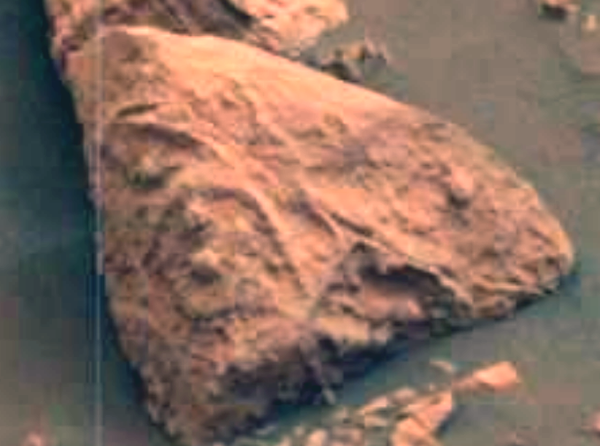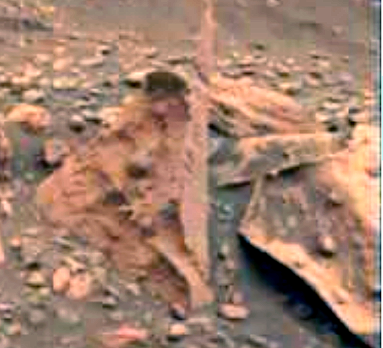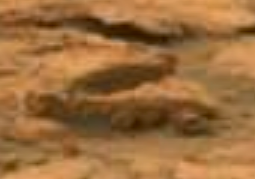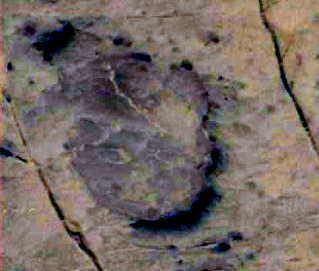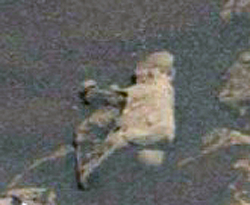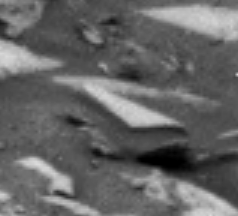It looks like you're using an Ad Blocker.
Please white-list or disable AboveTopSecret.com in your ad-blocking tool.
Thank you.
Some features of ATS will be disabled while you continue to use an ad-blocker.
share:
originally posted by: Archivalist
a reply to: 727Sky
I like that image as much as the next tinfoil hat wearer.
However, it's not perfectly symmetrical. Seeing a recognizable shape and pattern, in this case, is most likely just our imaginations.
If that thing had perfect bilateral symmetry, I guarantee JPL and NASA would have driven right up to it.
However, round shapes like the "eye" are commonplace in nature, even non-living nature.
When molten rock splashes around and cools, it will tend towards spherical shapes.
Rocks will wear down, and have rounded edges, over time.
Craters and falling debris will make nice circular pads, which give rise to more circular appearances.
If just the surface of a rock heats up, and then cools down, you will approach spheroids as well.
Many many reasons, even just random chance.
Given how poor the overall resolution is, with any of Curiosity's individual cameras, the appearance of teeth, is possibly a complete camera artifact. Even if it does actually appear that way, Mars gets cold. Very, very cold.
Freeze damage to rocks, can make cracks that look like that "teeth" structure.
I fully believe in the possibility of actual current life on Mars.
I just don't think this particular rock, is a golden goose. More like, a rubber ducky, at best.
Yep just thought it was... Interesting... With the winds and sand storms of mars there are not many things that would surprise me by their appearance.
This one is also interesting, note the object near the centre.
I have no idea what it is, looks like a starfish animal/plant thingy.

I have no idea what it is, looks like a starfish animal/plant thingy.

originally posted by: amazing
originally posted by: Blue Shift
Finally getting back to areas where we're not just looking at cracked bedrock. I'm still pondering this one:
mars.jpl.nasa.gov...
And this little cluster from another thread:
mars.jpl.nasa.gov...
I guess what happens is that some kind of mud (?) leaked out of cracks in the rock and dried in these root-like shapes.
Why does it appear that NASA never closely examines the weirdest looking rocks? I want closer looks at these things!
Simple they only look weird when extreme zoom is applied, you get artifacts and start to see the jpeg compression of the image.
I blame movies and CSI for people assuming you can zoom above 100% resolution and get more detail you cant !
originally posted by: Jonjonj
This one is also interesting, note the object near the centre.
I have no idea what it is, looks like a starfish animal/plant thingy.
Stuff, things, etc. Blowing dirt fills in cracks and hardens. The rest of the rock wears away over time, making them look like tentacle creatures, I guess. There's more than one.
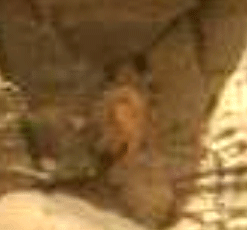
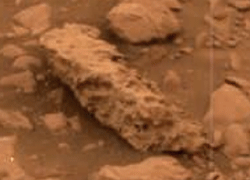
originally posted by: wmd_2008
I blame movies and CSI for people assuming you can zoom above 100% resolution and get more detail you cant !
True. But these images are basically reconstructed data, and it's possible to manipulate that data in ways that make certain features of the images clearer, or at least shows the differences in color and therefore mineral composition between various rocks. They could process the recent images so they don't look so washed out and orange, even with the dust storm.
Still my favorite:
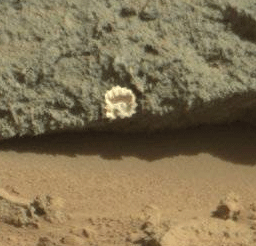
originally posted by: 727Sky
a reply to: Blue Shift
How about eyeballs and teeth !!
Those were added by an ATS member who used the rock -- which already looked kind of face-like -- to create a funny gif. It's somewhere in another thread around here.
a reply to: Blue Shift
On that image? That rock is your favorite?
Dude, that image is LOADED with interesting stuff.
Especially if you look for the color variations.
There's pale yellow, bright green, crimson red, etc...
There's also loads of rocks that look the same as other rocks in the same image, and somewhat resemble an animal skull.
Thanks for posting the link for the full, that IS a really good one.
On that image? That rock is your favorite?
Dude, that image is LOADED with interesting stuff.
Especially if you look for the color variations.
There's pale yellow, bright green, crimson red, etc...
There's also loads of rocks that look the same as other rocks in the same image, and somewhat resemble an animal skull.
Thanks for posting the link for the full, that IS a really good one.
imgur.com...
The newest image dump from the MAST CAM has one EXTREMELY interesting rock.
I snipped and enlarged some VERY interesting pieces.
Seems on topic
mars.jpl.nasa.gov...
Original Image
Have a gander, there is definitely something interesting going on, with this rock.
The newest image dump from the MAST CAM has one EXTREMELY interesting rock.
I snipped and enlarged some VERY interesting pieces.
Seems on topic
mars.jpl.nasa.gov...
Original Image
Have a gander, there is definitely something interesting going on, with this rock.
The original unusual rock, with lines added to illustrate what I see going on:
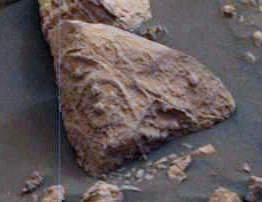

a reply to: Blue Shift
So, are you thinking like Algae/Moss ? Or Bacterial/Microbe colony?
That looks like some sort of organism or plant that would grow on a rock, and not distinctly a larger animal itself.
So, are you thinking like Algae/Moss ? Or Bacterial/Microbe colony?
That looks like some sort of organism or plant that would grow on a rock, and not distinctly a larger animal itself.
originally posted by: Archivalist
a reply to: Blue Shift
So, are you thinking like Algae/Moss ? Or Bacterial/Microbe colony?
That looks like some sort of organism or plant that would grow on a rock, and not distinctly a larger animal itself.
If anything, I'm thinking more along the lines of simple sponges or roots from reeds or water grasses that didn't leave an impression. The rover is currently poking around the old shorelines of what used to be a small river valley.
I generally don't look for "artifacts," but rather shapes that could indicate the remains of simple lifeforms. It's to tell if that's what they are exactly, though, since there are plenty of other purely geological or meteorological forces that can produce those kinds of shapes. That's why I mostly look for spirals or segmented curves. Something that natural processes wouldn't be able to duplicate.:
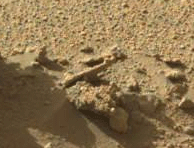


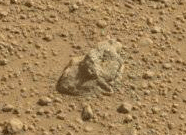

Okay, here's an "artifact" that caught my eye.
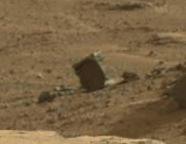
a reply to: Blue Shift
There are "artifacts" on the surface of Mars.
They're just not from extraterrestrials or ancient civilizations.
We (Earth) have had about 2 dozen missions out there, that could have left debris from impact.
Given that Mars has no atmosphere to burn up parts as they fall to the Martian surface, it's likely that there are probe bits and busted rover parts that are somewhat intact, and able to be distinguished.
It's lottery odds, sure, but impacts from orbital collisions usually have a very wide and long dispersion area.
(Like how a jetliner crash leaves debris for like 3~ miles)
Your finds and hunches for segments and simple lifeforms is a fantastic idea. I had similar thoughts last year.
I look for imprints or shapes that appear similar to Earth's cambrian ocean life forms.
I'd bet my bottom dollar that there are ammonite shell fossils on Mars.
There are idealized situations in which extremophiles could survive on Mars. I keep a very close eye on areas with calcium veins.
Months ago I figured out, that a process occurs with calcium carbonate(maybe carbonite, fuzzy memory)
When that compound heats up and then refreezes, it can use the CO2 in the "air" and will absorb and retain moisture like an advanced desiccant. (It's like 4 times more absorbent for moisture, than silica gel packs.)
That calc carbo material, is found in MANY shelled creatures on Earth.
Mollusks, arthropods, etc...
If an extremophile evolved to take advantage of that transitional moisture effect, I believe it could thrive there. The downside with that type of organism though, is that it would have a natural environmental camouflage. We probably wouldn't be able to tell it apart from a rock, unless we directly drilled into it. (Any large organism on Mars will be just as covered with oxide dust, as the rest of the planet.)
I also believe it's possible for epiphyte style plant life on Mars, since it has dust storms that move around the planet.
A plant like a tumbleweed, could just have a "hibernation" stage, until it winds up in favorable conditions.
Food for thought, on your image searches.
There are "artifacts" on the surface of Mars.
They're just not from extraterrestrials or ancient civilizations.
We (Earth) have had about 2 dozen missions out there, that could have left debris from impact.
Given that Mars has no atmosphere to burn up parts as they fall to the Martian surface, it's likely that there are probe bits and busted rover parts that are somewhat intact, and able to be distinguished.
It's lottery odds, sure, but impacts from orbital collisions usually have a very wide and long dispersion area.
(Like how a jetliner crash leaves debris for like 3~ miles)
Your finds and hunches for segments and simple lifeforms is a fantastic idea. I had similar thoughts last year.
I look for imprints or shapes that appear similar to Earth's cambrian ocean life forms.
I'd bet my bottom dollar that there are ammonite shell fossils on Mars.
There are idealized situations in which extremophiles could survive on Mars. I keep a very close eye on areas with calcium veins.
Months ago I figured out, that a process occurs with calcium carbonate(maybe carbonite, fuzzy memory)
When that compound heats up and then refreezes, it can use the CO2 in the "air" and will absorb and retain moisture like an advanced desiccant. (It's like 4 times more absorbent for moisture, than silica gel packs.)
That calc carbo material, is found in MANY shelled creatures on Earth.
Mollusks, arthropods, etc...
If an extremophile evolved to take advantage of that transitional moisture effect, I believe it could thrive there. The downside with that type of organism though, is that it would have a natural environmental camouflage. We probably wouldn't be able to tell it apart from a rock, unless we directly drilled into it. (Any large organism on Mars will be just as covered with oxide dust, as the rest of the planet.)
I also believe it's possible for epiphyte style plant life on Mars, since it has dust storms that move around the planet.
A plant like a tumbleweed, could just have a "hibernation" stage, until it winds up in favorable conditions.
Food for thought, on your image searches.
imgur.com...
Seems relatively on topic, for anyone interested there are multiple angles of this rock, with multiple rover cameras
Range of Images are mostly between SOL2115-SOL2125
Seems relatively on topic, for anyone interested there are multiple angles of this rock, with multiple rover cameras
Range of Images are mostly between SOL2115-SOL2125
edit on 29-7-2018 by Archivalist because: meh
Don't really know what this is. A chunk of insulation off the rover?

mars.jpl.nasa.gov...
They also decided to take another look at it a week later. Looks like it moved.
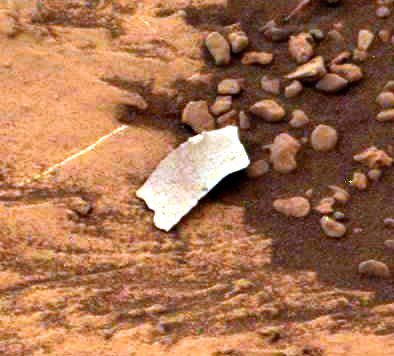
mars.jpl.nasa.gov...
There is also interesting stuff right below the piece of junk:
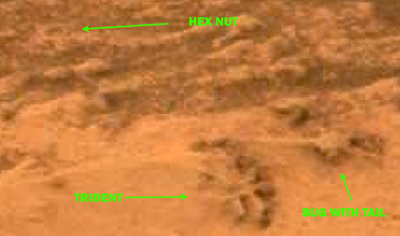

mars.jpl.nasa.gov...
They also decided to take another look at it a week later. Looks like it moved.

mars.jpl.nasa.gov...
There is also interesting stuff right below the piece of junk:

edit on 14-8-2018 by Blue Shift because: (no reason given)
Interesting texture. Maybe a flake of that calcium that's all over the place. Do I see the imprint of something in the left center. Could be
compression artifacts, I guess.
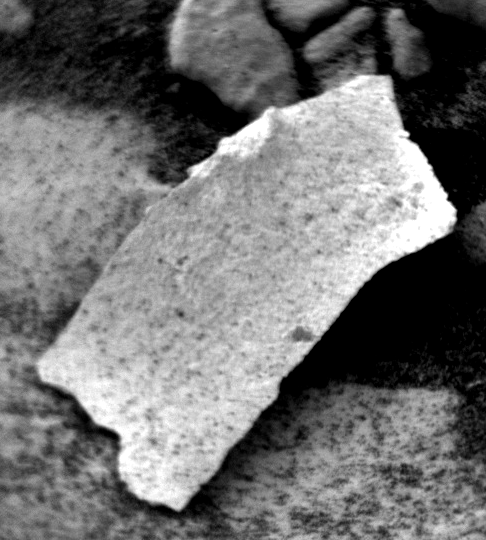
mars.jpl.nasa.gov...

mars.jpl.nasa.gov...
edit on
15-8-2018 by Blue Shift because: (no reason given)
new topics
-
Shane Gillis commercial
Jokes, Puns, & Pranks: 1 hours ago -
Elon Says It’s ‘Likely’ He Buys Tanking MSNBC
Political Ideology: 3 hours ago -
Montelukast affects brain, caused 5 year old to attempt suicide
Medical Issues & Conspiracies: 4 hours ago -
Jaguar Rebrand Video Causes "WTF?" Moment - Seriously Weird
Automotive Discussion: 6 hours ago -
Let's start a conspiracy
General Conspiracies: 7 hours ago -
What Joe Rogan said Vs The View
Dissecting Disinformation: 9 hours ago -
Biden's "Reckless" Decision To Escalate Russia-Ukraine War
World War Three: 11 hours ago
top topics
-
Biden's "Reckless" Decision To Escalate Russia-Ukraine War
World War Three: 11 hours ago, 16 flags -
Elon Says It’s ‘Likely’ He Buys Tanking MSNBC
Political Ideology: 3 hours ago, 14 flags -
Jaguar Rebrand Video Causes "WTF?" Moment - Seriously Weird
Automotive Discussion: 6 hours ago, 13 flags -
What Joe Rogan said Vs The View
Dissecting Disinformation: 9 hours ago, 11 flags -
Montelukast affects brain, caused 5 year old to attempt suicide
Medical Issues & Conspiracies: 4 hours ago, 10 flags -
Let's start a conspiracy
General Conspiracies: 7 hours ago, 1 flags -
Shane Gillis commercial
Jokes, Puns, & Pranks: 1 hours ago, 1 flags
active topics
-
Elon Says It’s ‘Likely’ He Buys Tanking MSNBC
Political Ideology • 59 • : KrustyKrab -
Biden's "Reckless" Decision To Escalate Russia-Ukraine War
World War Three • 119 • : KrustyKrab -
Inca stone masonry at Sacsayhuaman, Ollantaytambo and the Sun Temple
Ancient & Lost Civilizations • 8 • : Hansllune -
Montelukast affects brain, caused 5 year old to attempt suicide
Medical Issues & Conspiracies • 5 • : marg6043 -
Well, here we go red lines crossed Biden gives the go ahead to use long range missiles
World War Three • 325 • : Oldcarpy2 -
A Mysterious Orb filmed over NYC by local news
Aliens and UFOs • 24 • : Lazy88 -
Well we know Putins ICBMs won't fail in their silos
World War Three • 169 • : Oldcarpy2 -
Shane Gillis commercial
Jokes, Puns, & Pranks • 0 • : theatreboy -
What Joe Rogan said Vs The View
Dissecting Disinformation • 18 • : bluesman023 -
Jaguar Rebrand Video Causes "WTF?" Moment - Seriously Weird
Automotive Discussion • 14 • : bluesman023

